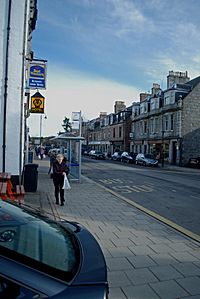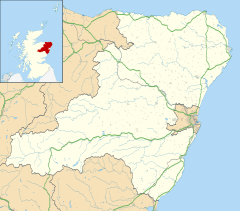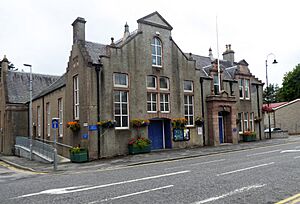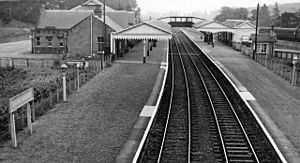Banchory facts for kids
Quick facts for kids Banchory
|
|
|---|---|
 Banchory High Street |
|
| Population | 7,440 (2020) |
| OS grid reference | NO698958 |
| • Edinburgh | 109 mi (175 km) |
| • London | 521 mi (838 km) |
| Council area | |
| Lieutenancy area | |
| Country | Scotland |
| Sovereign state | United Kingdom |
| Post town | BANCHORY |
| Postcode district | AB31 |
| Dialling code | 01330 |
| Police | Grampian |
| Fire | Grampian |
| Ambulance | Scottish |
| EU Parliament | Scotland |
| UK Parliament |
|
| Scottish Parliament |
|
Banchory is a town in Aberdeenshire, Scotland. It is located about 18 miles (29 km) west of Aberdeen. The town sits near where the Feugh River joins the larger River Dee.
Contents
Discovering Banchory's Past
In 2009, a farmer found an ancient burial site east of Banchory. Experts called archaeologists to explore it. They discovered it was a burial from the Beaker culture. This culture existed a very long time ago.
Tests showed the burial was from between 2330 and 2040 BC. Scientists studied the human remains. They found the person likely grew up nearby or possibly in a place like Yorkshire. A pot found in the burial once held butter or milk.
A Look at Banchory's History
The name Banchory may come from an early Christian settlement. This settlement was started by St Ternan. People believe St Ternan was a follower of St Ninian. He built his settlement by the River Dee. This spot later became the churchyard of Banchory-Ternan.
The village kept this name until the 1970s. The original Gaelic name is similar to Bangor in Northern Ireland. Bangor was also a monastery site. Special items linked to St. Ternan were kept in Banchory for many years. This continued until the Scottish Reformation, a big change in Scotland's church.
Two old Christian cross-slabs can still be seen near the old churchyard. One is a worn pink granite slab with two crosses. The other is a special ringed cross built into a wall.
Glen o' Dee Hospital was the first hospital of its kind in Scotland. It was built to help people get better. The hospital opened in 1900. It was mostly made of wood with a stone tower. All its rooms had balconies facing the river. Sadly, on October 13, 2016, the old hospital was destroyed by fire.
From 1946 to 1986, Banchory was famous for its lavender fields. This industry made the town known around the world.
Banchory Today
Banchory is the biggest town in its area. It has a main street with many shops and places to eat. You can find hotels like the Stag Hotel and the Burnett Arms. There are also newsagents, hairdressers, and chemists.
The town has grown a lot since the 1970s. Since 2001, it has expanded quickly. A large forest area called 'the Hill of Banchory' has become a big housing area. Many new people have moved to the town. A new school, Hill of Banchory primary school, opened in 2006. This was to help with the growing number of students.
Banchory Town Hall was finished in 1873. The Kinneskie Road drill hall was built around 1908.
Education and Sports in Banchory
Banchory Academy is a public secondary school. It can teach up to 900 students.
The Banchory Sports Village opened in 2019. It is in the Hill of Banchory area. This modern facility has a 25-meter swimming pool with six lanes. It also has a gym and a sports hall.
Fun Things to Do in Banchory
Banchory is often called the "Gateway to Royal Deeside." This means it's a great starting point for exploring the beautiful Royal Deeside area.
The Banchory River Festival used to happen every June. The main event was held in Bellfield Park. The Banchory Show is held every July. It features an Agricultural Show and a Dog Show. There is also a Craft Fair and Highland Dancing. You can even watch the Scolty Hill Race. Traditional fairground games are also part of the fun.
Scotland's only Rum distillery, Dark Matter Distillers, is located near Banchory.
Getting Around Banchory
In 1853, Banchory railway station opened. It was part of the Deeside Railway. The station closed in 1966. Today, the town is on the Deeside Way. This is a path for walking and cycling. It follows the old railway track.
In 2017, the local bus service in Banchory was stopped. However, a new internal bus service was started again in 2020.
Famous People from Banchory
- John Macqueen Cowan (1891–1960), a botanist who studied plants.
- James Scott Skinner (1843–1927), a famous fiddler and composer.
- Andrew Lang (1844–1912), a writer and expert on folklore. He lived in Banchory in his later years.
- Caroline Phillips (1874–1956), a Scottish journalist and supporter of women's right to vote. She owned a hotel in Banchory.
- Pete Cashmore (born 1985), who started the popular technology website Mashable.
- Ben Kilner (born 1988), a snowboarder who competed in the Winter Olympics.
- Norman Douglas (1868–1952), a Scottish novelist and travel writer.
- Andrew Considine (born 1987), a Scottish international football player.
See also
 In Spanish: Banchory para niños
In Spanish: Banchory para niños




